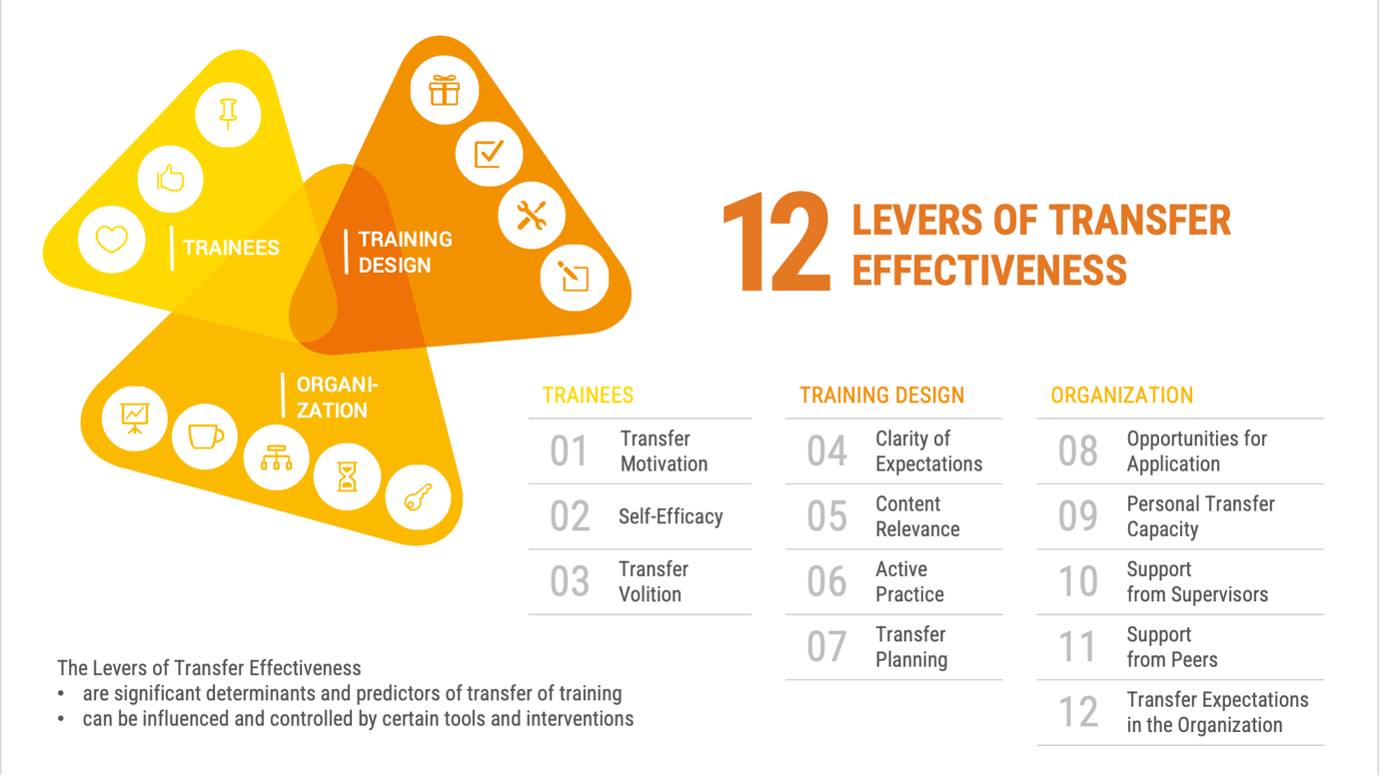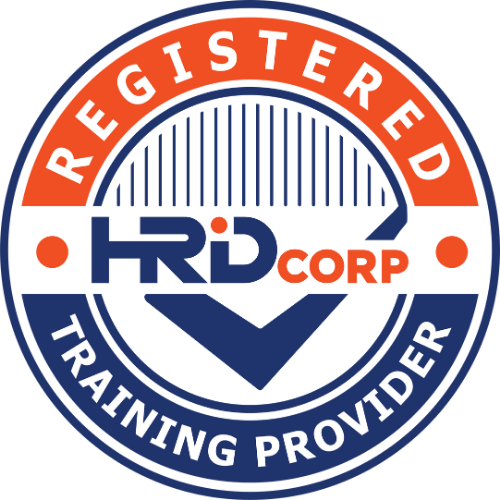Applicability of Learning Transfer Effectiveness forProject Management
To increase the effectiveness of learning and development programs, the Institute of Transfer Effectiveness has designed tools to create, unique learning journeys for participants, to enable them to translate that learning to on-the-job performance. This is based on the work done by Dr Ina Weinbauer who has painstakingly developed an excellent learning transfer model that incorporate 12 transfer effectiveness levers within three components that impact transfer effectiveness of learning.
A summary of these levers of transfer effectiveness are indicated below:

This article seeks to determine how the 12 levers of transfer effectiveness may be applied for training and development programs conducted in the area of project management.
By 2027, some 88 million people around the world are likely to be working in project management, and the value of project-oriented economic activity will have reached $20 trillion. Based on research, only 35% of the projects undertaken worldwide are successful. This finding has been collaborated by a study undertaken by The Standish Group’s annual CHAOS 2020 report found that 66% of technology projects based on an analysis of 50,000 projects annually end in partial or total failure.
Given that the project management industry is set to grow by USD 6.6 trillion by the end of 2020, this statistic implies that 9.9% of every dollar spent is wasted due to poor project management.
Despite increasing level of investments made to upskill project managers and project team members over last decade, this trend of declining project performance is a major source of concern.
The primary reason for this is the inability to effectively transfer what was learnt in the class into the project work environment. The issue is not the lack of knowledge about project management, it is the inability apply what was learnt in practice within a project-based setting.
For the transfer of learning into a project environment to be effective, relevant baselines to evaluate the extent to which learning transfer has been effective has to be established.
These baselines must be developed in consideration of project success criteria such as actual vs targeted completion time, actual vs targeted budget as well as actual quality delivered vs targeted quality expected.
In addition, a support mechanism that is needed for project team members to apply their learning within a project environment must be established. This support must be obtained from both senior management, project sponsors as well as from other stakeholders that affect and are affected by the project in question.
This article will discuss both and suggest a solution that is both viable and practical for most projects.
Transfer effectiveness Evaluation.
The extent of improvement in project management capability requires a mechanism in place to to compare project performance over time. Since projects are unique, a common measure suitable for use in all types of projects needs to establish. It is proposed that overall baseline project performance be established indicating the current project management capability for project managers. This baseline should be an average of project performance for a fixed number of projects undertaken in the past.
1. Project Schedule Performance measured as a measure of time to complete a project in terms of
[Targeted Time to Complete] – [Actual Time to Complete]
-----------------------------------------------------------------------------------------
[Targeted Time to Complete]
2. Project Cost Performance measured as a measure of funds allocated and used in a project in terms of
[Targeted Cost Budgeted to Complete] – [Actual Cost incurred to Complete]
-----------------------------------------------------------------------------------------
[Targeted Cost Budgeted to Complete]
3. Project Scope Performance measured as a measure of funds allocated and used in a project in terms of
[Targeted scope required] – [Actual scope delivered]
-----------------------------------------------------------------------------------------
[Targeted Scope required]
The above may be computed as percentages that could be compared with a mean value of similar recently concluded projects that were undertaken before the training and development program. By doing so, some indication of the effectiveness of the learning being applied may be established.
An example of how this information may be useful for schedule performance is indicated below.
Targeted Time | Actual Time | Project Schedule | Extent of Learning
transfer Effectiveness |
|---|---|---|---|
6 | 9 | -30% | Very Low |
6 | 7 | -16% | Low |
6 | 4 | 33% | High |
6 | 2 | 50% | Very High |
The gap between performance measures before and after the training will provide accurate information on whether project management skills acquired have been successfully implemented within a project environment.
Seeking ways and means to continually achieve a positive gap indicating better performance can and will motivate the team to seek better ways to seek project management training programs that are readily understood and easily applied in the project environment.
Developing and maintaining a support mechanism.
Based on research undertaken by Ms Ina Weinbauer of the Institute of Transfer Effectiveness, there are 12 levers of transfer effectiveness that must be leveraged upon for making training programs effective. These levers may be categorized in three main components that relate to
- The Training Design
- The Trainee
- The Organization
Insofar as the trainee is concerned, based on research undertaken by Ms Ina, the levers of transfer effectiveness include the trainee’s motivation for transferring the learning through:
- The development of a learning plan (transfer motivation),
- The strength of the belief in the ability of the trainee in applying and mastering the skills required (self-efficacy)
- The trainee’s ability and willingness to dedicate their attention and energy to the implementation of the transfer plan (transfer volition).
The organizations contribution to transfer effectiveness is acquired via:
- Personal transfer capacity,
- Clarity of expectation from the organization and
- Provision of opportunities for transfer of learning,
- Support from peers and supervisors.
This should be done at the end of the training program after a consensus is reached on what the project team should start doing that they have not done previously, what they should stop doing that has not helped them, what they should do more and what they should do less.
By developing a consensus that is documented by way of a list of agreed actionable items, the team will develop an action plan that is both workable and practical as they undertake their next project. This will demonstrate the trainee’s transfer motivation and self-efficacy.
However, given the complexities associated with dealing with real life project-based challenges, the learning plan may not be applicable for all projects. Hence a relatively simple, low visibility project should be identified to be undertaken.
Such a project that will serve as a prototype project will not only enable the team to introduce what they agreed to do but also be one in which collaborative efforts from all stakeholders may be undertaken. When such projects succeed, they may be defined as quick wins that will instill and sustain a high level of transfer volition.
For such projects, the expectations of the organization should be communicated at the end of the initiation phase to fulfill the requirement for clarity of expectations from the organization to be met. An example could be the issuance of a project charter signed by senior management authorizing the project and outlining the outer boundaries of the project. This should be done just before the planning phase.
Support from peers and supervisors is to be provide continually at the planning, execution as well as during the monitoring and control phases of the project. The type of support provided could include:
- Assessing performance at regular intervals to determine areas for improvement
- Directing the project team towards achieving the project objectives.
- Guiding the team towards achieving the overall purpose for undertaking the project.
- Provision of timely and effective feedback to maintain the momentum of the team.
By customizing the format and mechanism associated with the support to be in alignment with the complexity of the quick win project, the organizational contribution for transfer effectiveness will be in place for ensuring that opportunities for implementation of the transfer plan within the quick win project will be in place.
It is essential to ensure all parties associated with the learning process, that is the training provider, the trainee as well as the representative of the organization collaborate in working towards improving the project performance. By comparing the project performance of previous projects with that obtained by the quick win project, an indication of the transfer effectiveness may be established. The comparison of project performance values from the quick win projects provides a good basis for further consideration in terms of how to enhance learning transfer effectiveness moving forward.
This approach that routinely compares the results of a quick win project with previous project performance baselines, enhances the desire to continually apply project principles and concepts when undertaking projects. Hence, project management best practices will be normalized and consequently the percentage of projects completed successfully will increase.
By,
Dr. Rumesh Kumar,
Certified Professional Trainer,
Certified Project Management Professional (PMP),
ScrumStudy Certified Trainer,
Certified Knowledge Manager,
Certified Tetramap facilitator.
References
https://en.wikipedia.org/wiki/Project_Management_Professional
https://hbr.org/2021/11/the-project-economy-has-arrived
https://www.linkedin.com/pulse/most-projects-fail-deliver-bartley-joseph
https://teamstage.io/project-management-statistics/






